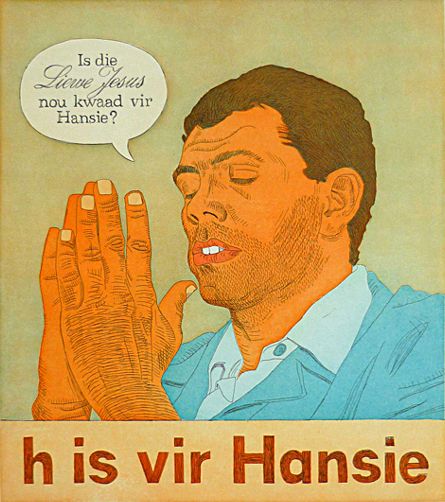h is vir Hansie
Store Review (0)PRESENTED BY : Warren Editions
| Frame | None |
|---|---|
| Edition Size | 25 |
| Medium | Hard ground and Aquatint on Zerkall Intaglio 250gsm |
| Height | 60.60 cm |
| Width | 53.60 cm |
| Artist | Anton Kannemeyer |
| Year | 2008 |
Hardground etching is a way of making fine line work. The best ground for line work is beeswax mixed with asphaltum and gum rosin. The plate can be handled without the ground being accidentally nicked. The plate is degreased, set on a heated surface and the ground, which comes in a ball, is spread onto it and then spread out evenly with a rubber brayer. When the wax cools, the plate is smoked with the flame of tapers. Thereafter, lines can be drawn through the ground with any pointed tool – the traditional one is a pointed metal cylinder called a needle. The resulting print is called a hardground etching. In using hardground, the artist can draw smoothly – all he or she needs to do is break the wax. The acid does the rest. The longer the plate is in the acid the deeper the bite and the stronger the lines will print.
Aquatint is a way of making tones. Despite the “aqua” in its title, the aquatint process does not involve water. It was invented in the mid-eighteenth century to simulate watercolour drawings. With aquatint one can capture a complete tonal range from a hint of a tone to mid-tones to shadows and darks. Aquatints can be airy like those in the etchings of Paula Rego to velvety like those in the etchings of Pablo Picasso.
Aquatint is made by a dense collection of tiny grains melted onto the plate and functions as a porous ground; each grain or clump of grains becomes an island that protects the plate, which the acid will bite around.
The most common means of applying the grains is with an aquatint box, made for creating and containing a rosin dust storm. After the dust storm is created, the plate is slipped into the box to collect the grains as they fall. Then it’s taken out and heated to melt the grains for them to adhere to the plate once cooled.









